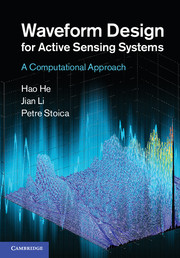Book contents
- Frontmatter
- Contents
- Preface
- Notation
- Abbreviations
- 1 Introduction
- Part I Aperiodic correlation synthesis
- Part II Periodic correlation synthesis
- Part III Transmit beampattern synthesis
- 13 Narrowband beampattern to covariance matrix
- 14 Covariance matrix to waveform
- 15 Wideband transmit beampattern synthesis
- Part IV Diverse application examples
- References
- Index
14 - Covariance matrix to waveform
from Part III - Transmit beampattern synthesis
Published online by Cambridge University Press: 05 August 2012
- Frontmatter
- Contents
- Preface
- Notation
- Abbreviations
- 1 Introduction
- Part I Aperiodic correlation synthesis
- Part II Periodic correlation synthesis
- Part III Transmit beampattern synthesis
- 13 Narrowband beampattern to covariance matrix
- 14 Covariance matrix to waveform
- 15 Wideband transmit beampattern synthesis
- Part IV Diverse application examples
- References
- Index
Summary
Chapter 13 focused on the optimization of the waveform covariance matrix R for transmit beampattern design. While designing R is an important step, the final goal is the waveform design and we might therefore think of designing directly the probing signals by optimizing a given performance measure with respect to the matrix X of the signal waveforms. However, compared with optimizing the same performance measure with respect to the covariance matrix R of the transmitted waveforms, optimizing directly with respect to X is a more complicated problem. This is so because X has more unknowns than R and the dependence of various performance measures on X is more intricate than the dependence on R (as R is a quadratic function of X).
In this chapter we consider the following problem: with R obtained in a previous (optimization) stage, we want to determine a signal waveform matrix X whose covariance matrix is equal or close to R, and which also satisfies some practically motivated constraints (such as constant-modulus or low PAR constraints). We present a cyclic algorithm for the synthesis of such an X. We also consider the case where the synthesized waveforms are required to have good auto- and cross-correlation properties in time. Several numerical examples are provided to demonstrate the effectiveness of the proposed methodology.
Problem formulation
Consider an active sensing system equipped with M transmit antennas. Let the columns of X ∈ ℂN×M be the transmitted waveforms, where N denotes the number of samples in each waveform.
Information
- Type
- Chapter
- Information
- Waveform Design for Active Sensing SystemsA Computational Approach, pp. 213 - 221Publisher: Cambridge University PressPrint publication year: 2012
Accessibility standard: Unknown
Why this information is here
This section outlines the accessibility features of this content - including support for screen readers, full keyboard navigation and high-contrast display options. This may not be relevant for you.Accessibility Information
- 2
- Cited by
